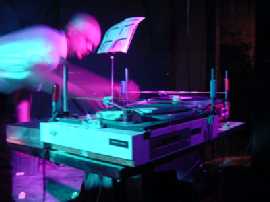Strotter Inst.

La utilización del vinilo como concepción artística nace a finales de los setenta cuando Christian Marclay los utilizó como fuente sonora. A partir de entonces renombrados artistas sonoros experimentan con las tornamesas como Otomo Yoshihide, Philip Jeck, Janek Schaefer, John Oswald, Bruce Gilbert, por nombrar algunos.
En 1998, Christopher Hess inicia su proyecto como Strotter Inst. después de 10 años de estar experimentando con cintas, loops y tornamesas. Tres años más tarde se edita el LP “Schlepper» en el sello suizo Eine Bauer im Anzug Produktion y en 2002 el CD-R “Eine Bauer im Anzug» en el mismo sello, además de apariciones en varios compilados. El año pasado, Everest Records publica su primer larga duración en CD, con el nombre de “Monstraz”. En este se plasma el trabajo de Hess consistente en la manipulación de cinco viejas tornamesas Lenco, en agujas y vinilos. Las tornamesas las hace girar a distintas velocidades y con alguna de sus partes encuentra nuevos materiales sonoros. Las agujas las deposita sobre vinilos, metales, maderas, etc. También reemplaza las agujas por cuchillas o cuerdas. Distintos componentes que en forma deliberada e improvisada crean ritmos, loops, resonancias y ambientes.
Más info en el sello: www.everestrecords.ch y en el sitio del artista: www.strotter.org
The use of the vinyl as an artistic conception started in the late Seventies when Christian Marclay used them like a sound source. From then, renowned sound artists have been experimenting with turntables in the likes of Otomo Yoshihide, Philip Jeck, Janek Schaefer, John Oswald, Bruce Gilbert, to name a few.
After 10 years experimenting with tapes, loops and turntables, in 1998, Christopher Hess started his project under the moniker of Strotter Inst. Three years later, the LP ‘Schlepper’ was released on the Swiss label Eine Bauer im Anzug Produktion and in 2002 the CD-R ‘Eine Bauer im Anzug’ was published on the same imprint, in addition to appearances in several compilations. Last year, the Bern-based Everest Records released his first full-length CD called ‘Monstraz’, the one that shapes his work with the manipulation of five old Lenco turntables, needles and vinyls. The first ones rotate at different speeds and with some of its parts he finds new sound objects. The needles lay on materials like vinyl, metal, wood, etc. Also he replaces the needles with razor blades or strings. Different components that in a deliberate and improvised form create rhythms, loops, resonances and atmospheres.
More info at: www.everestrecords.ch and www.strotter.org
¿Qué influencias tiene la arquitectura en tu música?
“No creo que la arquitectura tenga una influencia directa en mi música. Pero hay paralelismos. Por el término arquitectura no pienso sólo en edificios, sino que es la mayor manifestación de vivir en el espacio. Esa es la conexión con la música. Si deseo estar físicamente presente en el espacio, tengo que encontrar y fijar mi posición. Dentro de mi música quiero hacer lo mismo. De tal manera que hacer [especialmente en vivo] música es hacer un acto de arquitectura en sí mismo. Los fenómenos de la arquitectura no influencian las estructuras de los sonidos en las presentaciones en vivo”.
Parece que las estructuras rítmicas no están creadas a propósito, sino que por azar o a través de la improvisación. ¿Cuál es tu opinión al respecto?
“Para crear mi música paso por varias fases. Primero experimento con las tornamesas, las agujas y vinilos para saber qué va a salir de las cajas. Esto es solo para divertirme y sin un objetivo. Luego pongo las partes y sonidos que quiero juntar para encontrar conexiones entre los ritmos. En esta fase, trato de ver si puedo retocar los sonidos ya que las tornamesas, elásticos de goma y así sucesivamente, siempre trabajan algo diferente. Para completar un set intento buscar que fluya una historia sin un protagonista. Normalmente yo no hago las pistas. Pero en el escenario, como no puedo controlar las máquinas ciento por ciento, comienzo con mi actuación ya preparada y la mayor parte del tiempo la cambio mientras la escucho. Entonces mi música es una mezcla deliberada e improvisada”.
¿Qué clase de sonidos te gusta producir con las agujas?
“Lo más disímiles posibles entre sí. Es bastante importante. Comparado con los laptopistas, la audiencia puede seguir el sonido con sus ojos. Las agujas me dan la posibilidad de manejar distintas posibilidades. Primero la forma típica de depositarla sobre un vinilo, metal, madera, etc. Luego el modo indirecto, por ejemplo, dejando caer la aguja sobre una banda elástica, lo que es muy rítmico, por los pequeños pedazos que se vierten sobre la tornamesa. Y por supuesto, manipular la aguja o reemplazarla por una cuerda o una cuchilla y así sucesivamente. Finalmente sin la aguja, sino sólo con los sonidos de la tornamesa”.
¿Nos podrías explicar cómo trabajas con las cinco tornamesas?
“Frecuentemente toco con cinco tornamesas porque no puedo controlar todo de una sola vez. Me gustaría hacer un concierto con cientos de ellos. En una presentación en vivo dos o tres tornamesas están trabajando en un ritmo, en tanto que los otros dan soporte haciendo ruidos o preparan la siguiente parte. A veces los cinco están haciendo algo al mismo tiempo, a veces sólo lo hace uno de ellos. Dos de mis tornamesas Lenco se ponen juntos a través de una suerte de enchufe doble, para asegurarse de que tengan la misma velocidad. Los otros están libres. Los tornamesas que uso son Lenco a velocidades distintas que se encuentran entre las 16 y 78 revoluciones por minuto. Éstos son muy poderosos y tienen la misma construcción para la celda, entonces, aparte de los cinco tornamesas, tengo cerca de veinte agujas diferentes”.
¿Cuáles son los objetos o materiales que utilizas en tu trabajo?
“No estoy seguro si entendí tu pregunta. Me gustan los tornamesas en sí mismos. Y escuchar cómo cambian los sonidos y los ritmos, sólo dejando correr por horas los tornamesas. Por esto es que trabajo como Strotter Inst. y también en objetos encontrados, confeccionados éstos a partir de los mismos tornamesas”.
Texto: Guillermo Escudero
Marzo 2005
What influence has architecture in your music?
“I don’t think architecture has a direct influence in my music. But there are parallels. By the term architecture I don’t think of just buildings, it is more the main manifestation of living in space. That’s the link to the music. If I want to be physically present in space, I have to find and define my position. Within my music I want to do the same. So to make music [especially live] is an act of architecture itself. Architectural phenomenas don’t influence the structures of the sounds. In the live-shows.”
It seems that the rhythm structures are not created in purpose, but by chance or by improvising. What’s your opinion about?
“To create my music I go through different phases. First I experimentate with my turntables, needles and vinyl to look what comes out of the boxes. This is just for fun, without an aim. Then I put parts and sounds I like together to find connections between rhythms. In this phase I find out if I can replay the sounds, ‘cause the turntables, rubberbands and so on always act a little different. To finish a set I try to find a flow, a story without a protagonist. I usually don’t do tracks. But on the stage, as I can’t control the machines for 100%, I start with the prepared set and most of the time I change it by listening what happens. So my music is a mix of purpose and improvisation.”
What sort of sounds do you like to produce with the needles?
“As different as possible. The visual aspect is quite important. Compared to laptop-artists the audience can follow the sound by eyes. The needles give me different possibilities to handle. First the usual way by putting it on something like vinyl, metal, wood etc. Then the indirect way for example to lay the needle on a rubberband which is hit rhythmically by little pieces turning on the turntable. And of course by manipulating the needle itself or even replace it by a string or a razorblade and so on. Finally without a needle just with the sounds of the turntable itself.”
Please explain us how do you work with five turntables.
“Usually I play with five turntables because I can’t control more than that at once. I would like to do a concert with hundreds of them. During a liveset two or three turntables are working on a rhythm while the others are supporting that by noises or prepare the next part. Sometimes all five are doing something the same time, sometimes it is just one. Two of my Lenco turntables are put together by a kind of V-belt to be sure they have the same speed. The others are free. The turntables I use are Lencos with variable speed between 16 and 78 rpm. They are

